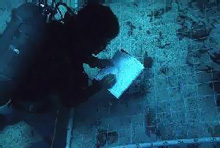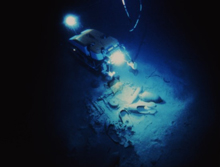A bronze statue of the Roman Emperor Augustus, recovered from an underwater site in the Aegean. The statute was cast about the year 10 B.C., and now is on display at the National Archaeological Museum in Athens. Click image for larger view and image credit.
Deep Water Archaeology
Brendan Foley
Chief Scientist
Why study shipwrecks?
Humans, ships, and the ocean are bound together in a complex relationship. In the ancient world, ocean transportation was the safest, fastest, and most economical method to move goods, people, and ideas from one place to another. As civilization spread from the lush river valleys of the Nile and the Tigris and Euphrates during the Bronze Age (roughly 3000-1000 BC), sea-borne trade made possible the occupation of less fertile lands including the Aegean islands. Through the Iron Age, Classical Greek period, Roman era, and medieval times, seagoing technology was critical to colonization of new lands, expansion of trade, establishment of empire, and development of markets. However, the ocean exacts a toll on this trade and communication; some percentage of voyages ended in shipwreck.
Shipwrecks are a random sample of voyages, a record of that ancient trade and communication. Unlike elaborately contrived sites such as graves and temples, shipwrecks are accidental and therefore show the past as it really was. Although it is easy to equate shipwrecks with gold and precious artifacts, most shipwrecks represent common activities, the regular mundane exchanges carried on in the background of society. One way to think about shipwrecks is that they are like car accidents at sea, but with no tow trucks to remove the wreckage.
Though the majority of shipwrecks might have carried bulk commodities like wine, grain, and olive oil, a few did transport prestige goods. Some types of high-value artifacts are found almost exclusively on shipwrecks, and are very rarely encountered on land sites. An example is tools or artworks made of bronze. The National Archaeological Museum in Athens holds a collection of fabulous bronze statues from the Classical, Hellenistic, and Roman eras. Almost all of those statues were recovered from underwater, not from land excavations. The reason is that bronze is valuable and easily recyclable, and if left on land it will be re-used. Bronze that originally may have been cast as a statue could be later melted down to make swords and shield if an enemy threatened. The bronze could have been reprocessed to make medieval church bells, and finally converted into cannon in the early modern period. Ancient bronze may still be around, but not in its original form. However, if an ancient bronze work of art or tool was lost aboard a sinking ship, it will persist on the seafloor for thousands of years. Bronze is very stable in seawater; it will not rust away like an iron object.
Why should we examine shipwrecks in deep water?
Over the past fifty years, scuba-diving archaeologists have made terrific discoveries by excavating shipwrecks in shallow water. Their work has delivered a better picture of the ancient world. However, scuba diving is generally limited to water shallower than 50 meters (150 feet). That means that only about 2% of the sea floor is within reach, and therefore we may only be seeing 2% of all shipwrecks. By using deep submergence technology, we have access to all of the sea floor in the Mediterranean region.
Another reason to look in deep water has to do with vessel types. If you visit any port today, you’ll notice there are different sorts of ships for different cargoes, missions, and trade routes. Tug boats, for instance, are designed to escort ships up and down harbors and rivers and seldom venture far from port. Private sailboats and motorboats usually ply coastal routes and inland waters. Bulk carriers and oil supertankers spend most of their working lives far away from port, only coming near shore when taking on or discharging cargo. Was sea travel in the ancient world any different?
If we only look in shallow waters, we may miss important components of ancient trade. Our research indicates that even as recently as the middle of the 19th century, nearly 20% of shipwrecks occurred in deep water away from shore. These vessels are the body of evidence we intend to study. By comparing deep water and shallow water wrecks with information from land excavations, we will get a new understanding of the ancient world.

Over the past fifty years, scuba-diving archaeologists have made terrific discoveries by excavating shipwrecks in shallow water. However, scuba diving is generally limited to water shallower than 50 meters (150 feet). That means that only about 2% of the sea floor is within reach. Image courtesy of the National Park Service.

Advanced robotic technologies have been used to study shipwrecks and other underwater archaeological sites for 17 years. Robotic vehicles can map and photomosaic a shipwreck with quantifiable accuracy in the space of a few hours, and enable access to sites resting on the other 98% of the seafloor. Click image for larger view and image credit.
What do we mean by “deep water”?
If scuba-diving depths are 50 meters or less, then we can think of anything beyond that as deep water. The Mediterranean Sea is as much as 5000 meters deep, and averages about 3000 meters. Elsewhere, the world’s oceans plunge to depths of 11,000 meters. Certainly that is deep water!
To the PHAEDRA team, the term ‘deep water’ has little to do with actual depth. Instead, we think of deep water in terms of the technology and methods necessary to access those depths. The required robotic systems, in situ sensors, precision navigation, and rigorous, technology intensive survey methods are what sets deep water archaeology apart from its shallow water cousin.
Advanced technologies are critical to conducting science in great depths of water, but our systems and techniques can be used in shallow water, too. Our 2005 surveys at Chios showcased the potential of underwater vehicles for easing diver-based archaeology. Most diving time on archaeological sites is consumed with basic mapping tasks. Typically it takes hundreds of diving hours to make a site plan using tape measures and clipboards. In contrast, robotic vehicles can map and photomosaic a shipwreck with quantifiable accuracy in the space of a few hours. By combining deep water archaeological technology and methods with standard archaeological diving practices, we can free the divers to do the things they do best. That includes excavating; but even more importantly, thinking. Archaeologists should spend their time analyzing and interpreting the site instead of being mired in repetitive tasks.
Deep water archaeology offers new ways of doing archaeology, while presenting entirely different types of information about the ancient world. It may be that through the study of deep water shipwrecks, we can glimpse the prehistoric moment when civilization crystallized and the modern world began.
Sign up for the Ocean Explorer E-mail Update List.


















